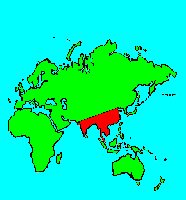SPECIES INFO
Orange bellied leafbird (Chloropsis hardwickii) is found from India east across SE Asia to southern China. This is also found south to Malaysia and Sumatra. This bird prefers wooded elevations from 3,000 to 8,000 feet. This 7.5 inch leafbird can be recognized by its black face and black throat. There is a small pale spot below the eye. The cape and back are green. The leading dorsal edge of the wings is blue-Grey, but marked with white. The upper breast is orange. The tail is blue.
There are four subspecies. The nominate subspecies Chloropsis hardwickii hardwickii is found in the eastern Himalayan Mountains through much of SE Asia to Hainan in southern China. The subspecies melliana is found in southern China to northern Vietnam. The subspecies luzulina is found in Hainan in southern China. The subspecies malayana is found in the Malaysian Peninsula.This leafabird genus (Chloropsis) is found from India and Sri Lanka (Ceylon) east through SE Asia to SW China and south to Borneo, Sumatra, Java, and the Philippines. These are small to smaller green birds with lengths normally between 6 and 8 inches long. The females are usually all green, and the males usually have a black throat area.
There were 8 species in the genus per Clements in 2007.
However, in the 2018 Princeton Illustrated Checklist of the Sundas and the Philippines, two new species are introduced.
The Sumatran Leafbird - Chloropsis media
The Bornean Leafbird - Chloropsis kinabaluensis
The Leafbirds (Families Chloropseidae and Irenidae) have been changed and modified again and again. Some authors have included the Orthonychidae with its 2 species in this group. The family Irenidae per Monroe in 1993 had 10 species, and the family Orthonychidae had 2 species.
Howard and Moore in 2003 have limited this family to 1 genus (Chloropsis) with a total of 8 species. Herein we follow Howard and Moore.
This family is found from southern Asia to the Philippines and south to Sumatra. Most members of this family are very highly colored.
This portion of the Corvoidea is found from south east Asia to Australia. This group contains mostly small to medium sized birds of attractive coloration. Australian robins, fairy bluebirds, leafbirds, log runners, and babblers belong here.
Australian-New Guinea robins(44-45) , fairy bluebirds(2), leafbirds(8), log runners(2), and New Guinea babblers(5) are an assemblage of 5 different taxonomic groups (families) with a limited range from south east Asia to Australia with species that share many characteristics. The families are as listed above as follows: Petroicidae(44-45), Irenidae(2), Chloropsidae (8), Orthonychidae(2), and Pomatostomidae(5).
We have also added the berrypeckers(12) (Family Melanocharitidae) to this group.
In most modern bird taxonomies, the perching birds (Passeriformes) is treated as a single order. This large order has about 5739 different species. A common characteristic of this order is three forward toes and one reverse pointing toe. Most of species are also characterized by a tendon locking mechanism that permits their feet to lock onto branches when they relax. Recently, Monroe and Sibley in 1993 have divided this large order into six main divisions. To help our users navigate this gigantic number of species, we have arbitrarily placed these 6 different divisions at the order level.
This division can be referred to as:
Order Passeriformes (5739 species)
Suborder Passeri (4580 species)
Parvorder Corvida (1103 species)
Aves contains about 8,650 different species of living birds known to science. Each year about one new species is discovered in some remote rain forest or remote island. In addition, scientists have been raising many subspecies to full species status which may raise the species count to 10,000. Birdlife recognizes 10,027 species as of 2011.
However, each year about one species goes extinct. The rate of extinction is increasing, and the rate of new discovery is decreasing, so that the number of bird species will soon begin to decline rapidly. Although different taxonomists would organize the birds differently, there are approximately twenty-seven orders of birds. These orders are broken down into about one hundred and fifty-five different families.
Recent research of the genetic structure of some of the shore birds and owls would indicate that the present organization of orders and families should have some modification.
The birds are a worldwide group of animals that are characterized by having the front limbs modified into wings that are used for flying. Perhaps the most unique feature of the birds is the feathers. These feathers are made up of a central support called a quill and a series of small filaments that are hooked together as barbs.
For many years it was believed that Archaeopteryx discovered in Bavaria was the oldest bird from about 150 million years ago. However, in l986, Sankar Chattterjee, a Texas paleontologist, reportedly discovered a bird in the genus Protoavis that lived about 225 million years ago.
When this project was begun in 1978, we used Austin & Singer for bird taxonomy. Since then, we have adopted many changes, but have kept some older concepts that are still found widely in the literature. Recently, we have used Clements and Howard & Moore. Very recently, we have used Monroe and Sibley for the higher taxonomy of the perching birds.
Backboned Animals (Phylum Chordata) are the most advanced group of animals on earth. These animals are characterized by having a spinal cord or backbone. Most members have a clearly defined brain that controls the organism through a spinal cord. Fish, amphibians, reptiles, birds, and mammals are in this phylum.
Currently, some taxonomists believe that the fish should be divided into two groups (sharks and regular fishes) and that there are some other primitive groups in the phylum such as hagfish or lampreys.
Animal Kingdom contains numerous organisms that feed on other animals or plants. Included in the animal kingdom are the lower marine invertebrates such as sponges and corals, the jointed legged animals such as insects and spiders, and the backboned animals such as fish, amphibians, reptiles, birds, and mammals.


